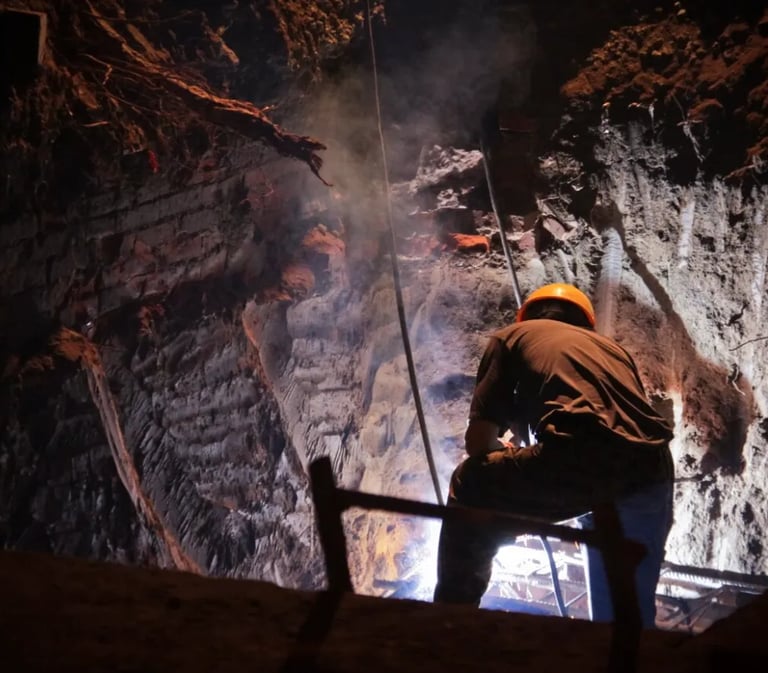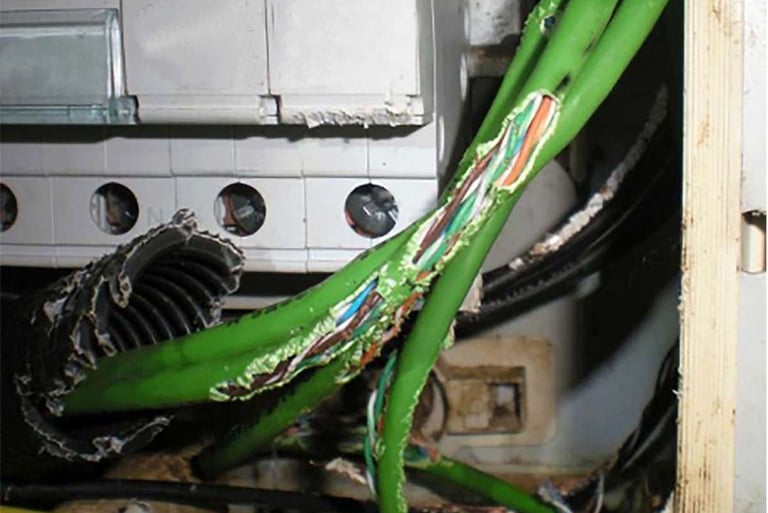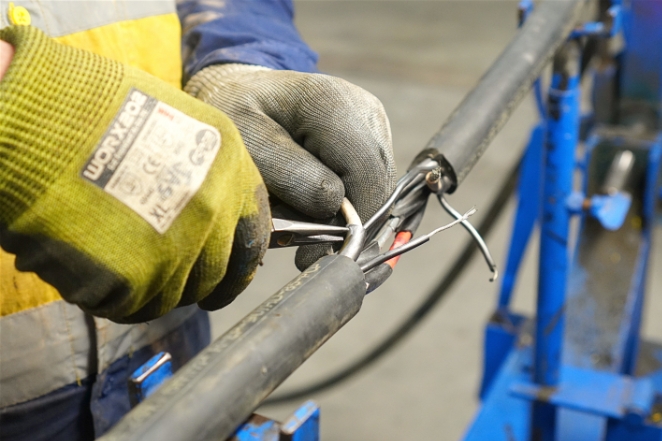Anhui Feichun Special Cable Co.,Ltd Li.wang@feichuncables.com
How to Replace Damaged Outer Sheaths on Mining Cables?
Learn how to identify, repair, and replace damaged outer sheaths on mining cables in South Africa. Expert guidance on SANS compliance, safety procedures, and when to repair vs replace mining cables.
Li.wang@Feichun Cable
7/21/202510 min read


In South Africa's demanding mining environment, from the platinum mines of the Bushveld Complex to the gold deposits of the Witwatersrand Basin, mining cables face some of the harshest operational conditions imaginable. The outer sheath of these cables serves as the first line of defence against moisture ingress, mechanical stress, flame exposure, fire hazards, hydrocarbon contamination, and aggressive chemical environments that are commonplace in our underground workings, open-pit operations, and offshore installations.
Whether dealing with low voltage (LV), medium voltage (MV), or high voltage (HV) mining cables, the integrity of the outer sheath is paramount to operational safety and regulatory compliance. Recent incidents at mining operations across the country have highlighted the critical importance of maintaining cable sheath integrity, particularly following the tragic events at various mines where electrical failures contributed to operational shutdowns and safety concerns.
The outer sheath acts as a protective barrier that prevents environmental contaminants from reaching the cable's inner components, including the insulation system and conductor cores. When this barrier is compromised, the entire electrical system becomes vulnerable to catastrophic failure, potentially resulting in unplanned downtime, equipment damage, and most importantly, risks to personnel safety.
Common Causes of Outer Sheath Damage in South African Mining Operations
Understanding the root causes of sheath damage is essential for implementing effective prevention strategies and determining appropriate repair or replacement approaches. In South African mining operations, several factors contribute to outer sheath deterioration.
Normal wear and tear represents the most predictable form of sheath degradation. Over time, even the highest quality cables will experience gradual deterioration of their protective outer layer due to environmental exposure and operational stresses. This process is accelerated in mining environments where cables are subjected to continuous vibration, temperature fluctuations, and chemical exposure.
Third-party mechanical strikes during installation or operation constitute another significant cause of sheath damage. Heavy machinery operations, blasting activities, and routine maintenance work can inadvertently damage cable sheaths through direct impact, crushing, or dragging across rough surfaces. The confined spaces typical of underground mining operations increase the likelihood of such incidents.
Chemical and hydrocarbon corrosion presents particular challenges in South African mining operations, where cables may be exposed to aggressive substances including acids, alkalis, and various hydrocarbon compounds. Underground mines often contain naturally occurring chemicals that can rapidly degrade cable sheaths, particularly those not specifically designed for such harsh chemical environments.
Abrasion damage frequently occurs due to poor cable routing practices or inadequate cable support systems. When cables are not properly secured or are routed through areas with sharp edges or rough surfaces, the constant movement and friction can gradually wear away the protective outer layer. This problem is particularly acute in temporary installations or areas where cables must be frequently relocated.
Extreme temperature cycling and UV degradation affect cables in open-pit mining operations and offshore installations. South Africa's intense solar radiation can cause significant UV degradation of cable sheaths not specifically designed for outdoor exposure, while the dramatic temperature variations between day and night can cause thermal cycling stress that leads to cracking and brittleness.
Identifying Sheath Damage: Early Detection is Critical
Early detection of outer sheath damage is crucial for preventing more serious electrical failures and maintaining operational safety. Mining personnel should be trained to recognise both visual and operational indicators of sheath compromise.
Visual indicators include obvious signs such as cracks running along the cable length, swelling of the sheath material indicating internal pressure or contamination, brittleness where the sheath feels hard and inflexible, and colour changes that may indicate chemical attack or UV degradation. Surface roughening, chalking, or the appearance of a powdery residue on the cable surface can also indicate advanced sheath deterioration.
Electrical indicators often provide the first warning of sheath compromise. A drop in insulation resistance measurements typically indicates moisture ingress through damaged sheath areas. This moisture can create conductive paths that compromise the cable's electrical integrity and create safety hazards.
Unusual electrical behaviour such as frequent circuit breaker tripping, the occurrence of partial discharges detected during routine testing, or unexplained voltage fluctuations may all indicate sheath-related problems. These symptoms should never be ignored, as they often precede more serious electrical failures.
A pertinent field case example occurred recently at a platinum mine in Limpopo Province, where routine visual inspection revealed extensive sheath cracking on a 11kV cable supplying critical underground pumping equipment. Initially dismissed as superficial damage, subsequent insulation resistance testing revealed significant moisture ingress. The damaged cable eventually failed completely during a period of heavy rainfall, causing a week-long shutdown of the pumping system and resulting in significant production losses. This incident underscores the importance of taking sheath damage seriously, regardless of how minor it may initially appear.
When Can Repairs Be Undertaken Safely?
Not all sheath damage requires complete cable replacement. Minor surface damage including superficial abrasion, small nicks, and minor cuts can often be effectively repaired using compatible sheath repair kits, provided the damage has not penetrated to the underlying insulation system.
Cold-applied repair sleeves and heat-shrink sleeves designed specifically for cable sheath repair can provide effective protection for minor damage. These materials must be compatible with the original sheath material and environmental conditions. Adhesive-based repair systems can also be effective for certain types of superficial damage.
Proper surface preparation is critical for successful repairs. The damaged area must be thoroughly cleaned to remove all contamination, moisture, and loose material. The cable surface should be prepared according to the repair kit manufacturer's instructions, which typically involve light abrasion to improve adhesion.
All repairs must follow manufacturer guidelines and comply with SANS 10198-9 requirements. This South African National Standard provides specific guidance on cable installation and maintenance practices in mining environments. Failure to follow these guidelines can result in repair failure and potential safety hazards.
The effectiveness of any repair must be verified through appropriate testing, including visual inspection of the completed repair and electrical testing to ensure the cable's integrity has been maintained. Documentation of all repairs is essential for maintaining compliance with regulatory requirements and tracking cable condition over time.
When Should Complete Cable Replacement Be Considered?
Certain types and extents of sheath damage cannot be safely repaired and require complete cable replacement. Understanding when replacement is necessary versus when repairs are adequate is crucial for maintaining operational safety and avoiding costly failures.
Severe or extensive sheath damage that affects significant portions of the cable length cannot be effectively repaired. Multiple repair points along a single cable run create potential failure points and may indicate underlying problems with the cable installation or environmental conditions.
Any damage that exposes the inner insulation system or conductor layers requires immediate cable replacement. Once the protective sheath barrier has been breached to this extent, the risk of electrical failure becomes unacceptably high, and repairs are unlikely to provide reliable long-term protection.
Evidence of water ingress inside multi-core cables, particularly where moisture has reached the conductor level, necessitates complete replacement. Once moisture has penetrated the cable core, it can migrate along the cable length and cause failures far from the original damage point.
Previously failed repairs or situations where repairs could not restore the cable's mechanical and electrical integrity also indicate the need for replacement. Attempting multiple repairs on the same cable section often indicates fundamental problems that cannot be addressed through repair alone.
The critical principle that must guide all decisions is that safety should never be compromised to reduce costs. The consequences of cable failure in mining environments can include fire, electrocution, equipment damage, and production interruption. These risks far outweigh the costs of proper cable replacement.
Cable Replacement Procedure: A Systematic Approach
When cable replacement is necessary, following a systematic procedure ensures safety, compliance, and optimal results. This process should never be rushed, as proper planning and execution are essential for successful outcomes.
Step 1 involves comprehensive site inspection and damage assessment. This includes documenting the extent and nature of the damage, identifying potential causes, and assessing the suitability of the existing cable route and support systems. Environmental conditions that may have contributed to the original damage must be evaluated and addressed.
Step 2 requires proper isolation and de-energisation of the cable system. This critical safety step must follow established lockout/tagout procedures and include verification that the cable is completely de-energised before work begins. All relevant personnel must be notified of the planned work.
Step 3 encompasses cable tracing, joint location identification, and removal planning. The complete cable route must be mapped, including all joints, terminations, and support points. A detailed plan for cable removal must be developed that considers access requirements, equipment needs, and safety procedures.
Step 4 involves the safe removal and proper disposal of the damaged cable. Environmental considerations are particularly important in South African mining operations, where cables may contain materials requiring special disposal procedures. All applicable environmental regulations must be followed.
Step 5 covers the installation of new SANS-compliant cable. The replacement cable must meet or exceed the specifications of the original installation and be appropriate for the environmental conditions. Proper installation techniques must be followed to prevent damage during installation.
Step 6 requires comprehensive testing and documentation. This includes VLF (Very Low Frequency) testing, insulation resistance measurement, and any other tests specified by the cable manufacturer or applicable standards. Complete documentation of the installation and test results must be maintained.
Throughout this process, compliance with SANS 1520-1, SANS 10198, and mine-specific safety protocols is mandatory. These standards provide the framework for safe and reliable cable installations in South African mining environments.
Safety and Compliance Considerations
The risks associated with ignoring outer sheath damage extend far beyond simple equipment failure. Fire hazards represent perhaps the most serious concern, as damaged cable sheaths can allow moisture and contaminants to reach energised conductors, potentially creating conditions for electrical arcing and ignition of flammable materials commonly present in mining environments.
Electrocution risks increase significantly when cable integrity is compromised. Personnel working near or handling damaged cables face increased risk of electrical shock, particularly in the high-moisture environments typical of many mining operations. The consequences can be fatal, making proper attention to cable condition a life-safety issue.
Asset failure resulting from neglected cable problems can have cascading effects throughout mining operations. Critical systems including ventilation, pumping, and materials handling can all be affected by cable failures, potentially impacting the safety and productivity of entire mining operations.
Legal responsibility for maintaining cable integrity rests with mining operators, who must demonstrate due diligence in equipment maintenance and safety management. The National Regulator for Compulsory Specifications (NRCS) in South Africa has clear expectations regarding electrical safety in mining operations, and failure to maintain proper standards can result in regulatory action.
Record-keeping and inspection reporting requirements are integral parts of compliance obligations. Detailed records of cable condition, repairs, replacements, and testing must be maintained and made available to regulatory authorities upon request. These records also provide valuable data for optimising maintenance programs and preventing future failures.
Preventive Measures: Protecting Your Investment
Implementing effective preventive measures represents the most cost-effective approach to managing cable sheath integrity. Proper cable routing and mechanical protection from the initial installation stage can prevent many common causes of sheath damage.
Cable routing should avoid sharp edges, high-traffic areas, and locations where mechanical damage is likely. Where exposure to potential damage cannot be avoided, appropriate mechanical protection including armoured cables, protective conduits, or cable trays should be implemented.
Anti-abrasion sleeves and cable carriers provide additional protection in high-wear environments. These protective systems are particularly valuable in temporary installations or areas where cables must be frequently relocated. The investment in proper protection systems is typically recovered through reduced maintenance costs and improved reliability.
Scheduled inspection routines enable early detection of developing problems before they become serious failures. These inspections should be conducted by trained personnel using standardised procedures and documented for compliance and trend analysis purposes. The frequency of inspections should be based on environmental conditions and operational requirements.
Cable selection based on appropriate mechanical and environmental specifications is perhaps the most important preventive measure. Cables must be selected to withstand the specific conditions they will encounter, including temperature extremes, chemical exposure, mechanical stress, and moisture conditions. Attempting to save money by selecting inadequate cable specifications typically results in higher long-term costs due to premature failure and increased maintenance requirements.
Frequently Asked Questions
Q1: Can I use duct tape or PVC tape for quick sheath repair underground?
A1: Absolutely not. Only certified repair kits that comply with SANS standards should be used for any cable sheath repairs. Improper materials such as duct tape or PVC tape can actually worsen the situation by trapping moisture against the cable sheath and creating conditions that accelerate deterioration. These temporary fixes can also create fire hazards and may violate safety regulations. Always use proper repair materials designed specifically for cable applications.
Q2: How do I know if a sheath repair has failed?
A2: Several indicators suggest repair failure, including repeat damage occurring in the same area, abnormal moisture readings during routine testing, unusual electrical test results such as reduced insulation resistance, visible deterioration of the repair material, or recurring electrical problems in circuits served by the repaired cable. Regular monitoring of repaired cables is essential to detect failure early.
Q3: What if only part of the cable is damaged? Do I still need full replacement?
A3: This depends on the severity and location of the damage. If the damage is severe, extensive, or occurs near terminations or splice points, full replacement is typically safer and often more cost-effective in the long term. Multiple repair points on a single cable can create reliability concerns and may indicate underlying installation or environmental problems that need to be addressed through complete replacement.
Q4: Can a newly installed cable have sheath damage?
A4: Unfortunately, yes. Poor handling during transport or storage, excessive bending during installation, accidental strikes from construction equipment, or improper pulling techniques can damage even new cables. This is why post-installation testing and inspection are so important, and why proper installation procedures must be followed throughout the process.
Q5: Is outer sheath damage a common reason for mining cable failure?
A5: Yes, outer sheath damage is indeed one of the leading causes of cable failure in mining environments. The harsh conditions typical of mining operations, including mechanical stress, chemical exposure, moisture, and temperature extremes, make sheath damage almost inevitable over time. However, proper selection, installation, and maintenance practices can significantly extend cable life and reduce failure rates.
Conclusion
Replacing damaged outer sheaths on mining cables is not merely a maintenance task but a critical safety and operational requirement that demands professional attention and compliance with established standards. The harsh realities of South African mining environments, from the deep underground workings of the Witwatersrand to the challenging conditions of platinum and coal mining operations, make cable sheath integrity absolutely essential for safe and reliable operations.
Mining operators, maintenance teams, and electrical personnel must never underestimate or ignore sheath damage, regardless of how minor it may initially appear. The consequences of neglecting cable sheath problems can extend far beyond simple equipment replacement costs to include serious safety risks, regulatory violations, and significant operational disruptions.
Professional assessment of cable condition, adherence to national standards including SANS 1520-1 and SANS 10198-9, and implementation of proper maintenance procedures ensure not only regulatory compliance but also long-term operational reliability and, most importantly, worker safety. The investment in proper cable maintenance and replacement when necessary represents sound business practice that protects both human lives and operational assets.
As South Africa's mining industry continues to evolve and modernise, maintaining the highest standards of electrical safety through proper cable management becomes increasingly important. The principles and procedures outlined in this guide provide the framework for achieving these standards while supporting the continued success and safety of our vital mining operations.





Email Address: Li.wang@feichuncables.com
© 2025. All rights reserved.


One-click to Quickly Contact
Products
Offshore & Marine Cable
XLPE Cable
Contact
Company
Location:
Building A Private Science and Technology Park, Hefei Economic and Technological Development Zone, Anhui Province, China
